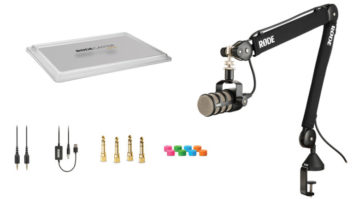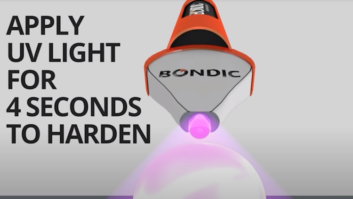
Fig. 1: What is it?
A couple of weeks ago, Hall Communications Vice President of Engineering Edd Monskie stopped in at the company’s AM station in Lancaster, Pa.
That studio has an old coffee cup sitting around, as do so many stations, filled with dried-up pens, pencils with broken points, dry Sharpies, rulers, broken rubber bands, twisted paper clips and assorted other things.
There, among the detritus, Edd found the item shown in Fig. 1. Do you know what it is?
Edd does — but he has no idea how it ended up in that coffee cup or how long it was there. The station has been at its current location since 1993 and has been fully computerized since it moved (a fact that gives you a hint). Read on for the answer.
* * *
Has the following ever happened to you?
When running premade Cat 5 cables, the lengths never end up exactly where you want them. The excess can be coiled up or looped, but where? Usually hanging down and running on the floor behind the rack. Sound familiar?
Gary Wachter, director of engineering for Service Broadcast Group of Grand Prairie, Texas, found a solution we all can use.

Fig. 2: Neat-Patch hides Cat-5 cable. “Neat-Patch” is just that: neat. It has the standard wire management fingers in front and a vented storage box in the rear. The excess cables can be coiled up inside and the ends brought out to the network switch, patch panel or Logitek JetStream Mini engine (as pictured in Fig. 2). Open the panel and the cables are tucked neatly inside, as in Fig. 3.
There is room inside for other small devices or adapters that you would want to hide. Four large round openings in the box section can be punched out and fitted with rubber grommets for cable entry if you desire.
When you’re finished dressing the cables, just snap on the cover panel, and everything is hidden.
Check out the Neat-Patch line at www.neatpatch.com for product description and distributors. Gary purchased it at an Altex Electronics store; visit www.altex.com.
* * *
Not all remote transmitter sites are equipped with running water and a sewage disposal system. Waterless or composting toilets can run on solar, 12 VDC or 120 VAC but cost $1,600 and up. Most RV and marine units need a holding tank and some source of liquid.
So, as you outfit your facility with emergency supplies, what to do about waste?

Fig. 3: The back door provides quick access. Engineer Bob Meister of Hamden, Conn., found the Go Anywhere portable toilet, made by Cleanwaste.
This collapsible, easy-to-assemble toilet is affordable and folds to the size of a small briefcase. For once-a-year emergencies, this might be worth having in your vehicle or at a remote site. Find it at outdoor suppliers like REI, or at Amazon.
* * *
OK, about the tool in Fig. 1. This was used to align the many heads of an IGM 48-tray Instacart automation system.
You’d put your head alignment cartridge on the removable tray and slip it in along with the tray, the tool resting on top of the test cart. You’d wiggle the tool to position the open end over the playback head, then manually start the tray playing while monitoring the output with a meter and scope. You’d twist the tool clockwise or counter-clockwise in short, snappy motions to try to find the peak of the high frequencies (and the proper phase, if you had a stereo Instacart).
While performing this procedure, you could not use the other 47 trays to play spots because there was only one stereo output for the entire 48-cart unit. You either changed programming to use your second Instacart — if you had one — or you came in overnight to do the alignment.
Fortunately, the system heads required alignment only about once a year, unless you got aggressive while cleaning heads and moved them a bit.
But Edd Monskie reminds us that the heads did have to be cleaned weekly, as with any heavily used cart system, or else they’d start missing stop and aux tones and might produce some pretty bad audio. A cart that didn’t recue properly might fire off other carts that were programmed to play, and you might have a half dozen or more sources playing at once.
Sometimes the heads even came loose and wobbled. That required removing the entire tray assembly, with the solenoid, out through the back to tighten up the head.
Tips to Live By Clay Freinwald’s recent column in the newsletter of SBE Chapter 124 brought smiles among the staff at Radio World.
He likes to offer tech tips. These should be made into a sign for posting in the shop at your station.
1) You only need two tools in life: WD-40 and duct tape. If it doesn’t move, but should, use WD-40. If it shouldn’t move and does, use the duct tape.
2) If you can’t fix it with a hammer, it must be an electrical problem.
3) Opportunities always look bigger coming than going.
4) Junk is something you keep for years and throw away three weeks before you need it.
5) Someone who thinks logically provides a nice contrast to the real world.
6) Blessed are they who can laugh at themselves for they shall never run out of material.
Number 4 is my favorite. Send me your own rules to live by at [email protected]. Usually by the time you had aligned half of the 48 individual heads, your hand was raw. Edd cut his engineering teeth on carousels at his first job in Michigan; he’d tape padding on the tool handle to preserve what flesh was left in his palm. The tool might look half like a pretzel by the time the job was done. This one is almost pristine; it shows only slight twisting.
Programming the system took some planning. Depending on the number of carousels available, your traffic department might have to make sure there was enough cue-up time to allow a carousel to eject a cart, rotate, pull the next tray in and be ready to play the next cart while the other carousels were playing. (Then some brain surgeon in production might complicate things by putting a 30-second spot on a 100-second cart.)
Edd later moved to Lancaster, where he found that the bookkeeper’s office still had two old ATC Stack 55s on one wall. This system used one large, threaded shaft moving a full ATC playback deck — the same size as the later Gates Criterion 80 decks — up and down to one of 55 carts that could be loaded in. Each Stack 55 was a full 7-foot rack height and must have weighed several hundred pounds.
It’s amazing what we used to work with. Edd, like many readers, could go on … How about Scully 270 reel-to-reels? What’s your favorite piece of nostalgia radio broadcast gear?
John Bisset marked his 40th year in radio in broadcasting recently. He works for Tieline Technology and is a past recipient of the SBE’s Educator of the Year Award. Reach him at [email protected] or (603) 472-5282. Faxed submissions can be sent to (603) 472-4944.
Submissions for this column are encouraged and qualify for SBE recertification credit.












